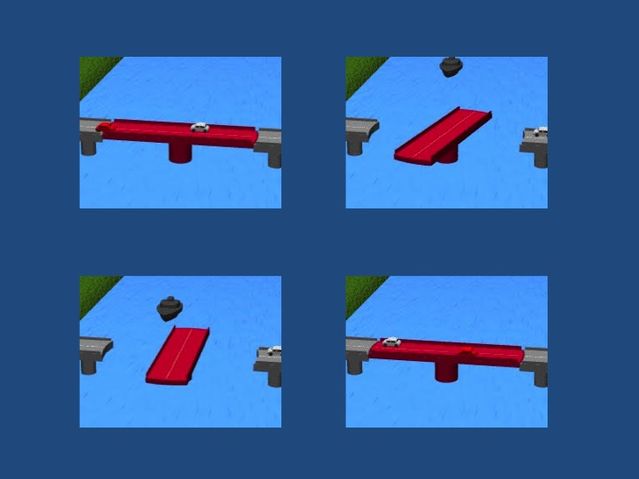Creativity
Brains, Bridges, and Creativity Boosts
Boosting creativity through thinking warm-ups
Posted January 2, 2016

“Truly, one of the most joyous things that I do in preparing for a performance is the warming-up part.” – opera singer Jessye Norman (from her 2014 book Stand Up Straight and Sing! p. 53)
Dancers and drummers, singers and swimmers, all regularly warm-up before their performances. Should we, too, sometimes be warming up before diving into a creative endeavor? If so, how might we better ready ourselves to innovatively think and make? And why might it work?
One promising warm-up approach is to imaginatively think of novel ways to use a common object, such as a brick or a chair. When we try to come up with new plausible “alternative uses” for an object, we draw on a wide variety of strategies to generate ideas.
Especially at first, we often call on our memory of different ways we have used the object, or have observed others using it. Might a brick serve as a doorstop? Or as sturdy support for some shelving?
As we continue thinking, we may imagine ourselves holding or touching or breaking apart the object. If we shattered a brick, could we use the clay fragments to catch rain runoff? Or (with a large number of bricks) use the fragments to surround a new fire-pit or barbequing area?
Moving up in abstraction, we might try to prompt ourselves with broader categories of possible uses. Could a brick be used for communication, perhaps as an implement to write in the sand or snow? Or for cooking, as a means to warm or heat food? Or perhaps for cleaning, say, as an abrasive scrub-bar for removing chewing gum from an outdoor surface, such as a footpath?
Based on research in my lab, people who used this warm-up technique for as little as 10 minutes proved to be more flexible and insightful problem solvers. We found that participants who first warmed up with the alternative uses task more often thereafter discovered the answers to insight puzzles, and achieved higher scores on novel visual-spatial reasoning tests. Those who warmed-up, outperformed people who did a simple word association task or people who did nothing at all.
So what does this have to do with bridges and brains?
A clue is provided from the recent findings of a group of researchers at the Ministry of Education and the School of Psychology in Chongqing, China. They asked how performing the alternative uses task might influence brain activity when participants were later simply resting quietly.
In the creativity “warm-up” phase, 34 participants (from a larger sample of 269 individuals) were provided a two-step opportunity to generate novel and unusual uses for everyday objects. First, participants were presented with pictures of each object (e.g., an umbrella) and were given 20 seconds to think of as many uses as they could. They then were given 8 seconds to report their ideas. Next, to further stimulate their thinking, they were shown ideas that were generated by other people for each of several different objects, and then asked again to generate their own ideas as before. These warm-up activities (with a 2-minute rest in between) together took less than 10 minutes.
The researchers then assessed the functional connectivity among brain regions when the “warmed-up” participants were simply resting quietly while in an fMRI scanner, and not performing any particular task. Compared to their baseline resting brain state, earlier having engaged in the alternative uses warm-up task significantly increased the strength of the communications between two brain regions: (1) the medial prefrontal cortex, and (2) the middle temporal gyrus. The medial prefrontal cortex often is active in internally-focused imaginative tasks such as story generation, future thinking, and improvisation. The middle temporal gyrus is known to be important in comprehending the meaning of concepts and in linking together or expanding ideas, as in moments of insight or metaphorical thinking.
Greater resting state connectivity between these two brain regions was also observed to be associated with performance on a standardized measure of verbal creativity in the larger sample of 269 adults. In the larger sample, resting state connectivity between these regions was significantly positively associated with greater originality, greater flexibility, and greater fluency on seven subtests taken from the Torrance Tests of Creative Thinking. The subtests included, for example, generating questions, causes and consequences about a pictured scenario, and finding several different ways to make a small toy more fun and enjoyable for children to play with.
The increase in communication (functional brain connectivity) after the creativity warm-up was shown for all of the warm-up participants. The increase was, though, particularly strong for participants who earlier had lower scores on the standardized creativity test. So everyone benefitted from the warm-up.
What does this all mean?
Our brains are not static entities. A great deal depends on what we’re asking our brain to do — and what we have, moments and minutes before, asked of our brain. Multi-purpose brain regions, such as the prefrontal cortex, flexibly change what they represent and how they work together with other regions depending on what they’re currently being “asked” to do. These multi-purpose brain regions change in response to our current goals and the particular task demands we are facing, such as how novel or challenging the task is. Equally important, our brain networks and sub-networks continually reconfigure their communicative “pathways” which allow information to be passed among them, from one to the other and back again.
Indeed, many studies demonstrate that there are several large-scale distributed brain networks involved in creative thinking and problem solving, including a 2015 study by Roger Beaty and colleagues. Although at times one network might be more active and others inactive, their relative roles might switch, and one network may become temporarily more prominent. For example, the salience network has been found to be important in switching between the default mode network (called upon during complex imaginative and reconstructive mental activities, such as our anticipations and planning of future events) and the executive control network (important in holding goals our in mind, in monitoring and evaluating our progress, and guiding and switching our attention). But at times, and especially during intense creativity, the default mode and executive control network may temporarily join forces.
The switching role of the salience network was underscored in a 2010 review by Steven Bressler and Vinod Menon. This switching role is abstractly diagrammed and described in my latest book (Innovating Minds: Rethinking Creativity to Inspire Change, Oxford University Press, 2015).

A simplified analogy might be the changing patterns of movement in highway versus boat traffic that occur with a swing-bridge at a river crossing. When the swing-bridge is opened, boats in the river can continue on their way up or down the river — but during that time the highway traffic (cars, trucks, motorcycles) must wait. Conversely, once the swing-bridge is closed and secured, vehicles on the road can proceed across the river, but the boats must now wait. Yet, a few miles farther down the river, there may be a high span bridge that allows both the river and the road traffic to proceed unhindered simultaneously.
Putting it all together — with some questions to continue thinking about:
- What we do before we embark on a creative endeavor matters. Our brain networks constantly reconfigure themselves. So to be more flexibly insightful we can warm-up with imaginative activities that deeply draw on our memories, perceptions, and experiential knowledge. Do you give yourself and others sufficient time and space to warm-up?
- Just like swing-bridges, functional brain pathways couple and de-couple, allowing different brain areas to receive and send information more or less freely. Do you selectively change what you are doing and how you’re doing it, even on the timescale of several minutes, to open up new creative possibilities for you?
- Imaginatively conjuring up alternative novel uses for a common object such as a paperclip or tin can has been shown to be one way we can warm-up for creative thinking. But what other activities might yield similar benefits? What about finding multiple possible meanings in apparently unrelated word pairs? What, for example, might an “elephant complaint” be? Or what’s an “octopus apartment”? How can you experiment to find your best thinking warm-ups?




